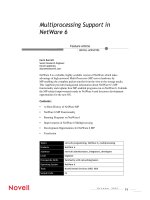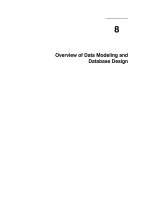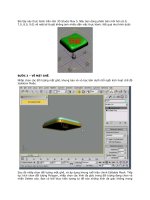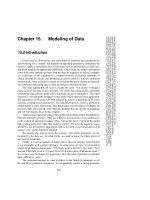Tài liệu Modeling Of Data part 6 pdf
Bạn đang xem bản rút gọn của tài liệu. Xem và tải ngay bản đầy đủ của tài liệu tại đây (173.73 KB, 9 trang )
15.5 Nonlinear Models
681
Sample page from NUMERICAL RECIPES IN C: THE ART OF SCIENTIFIC COMPUTING (ISBN 0-521-43108-5)
Copyright (C) 1988-1992 by Cambridge University Press.Programs Copyright (C) 1988-1992 by Numerical Recipes Software.
Permission is granted for internet users to make one paper copy for their own personal use. Further reproduction, or any copying of machine-
readable files (including this one) to any servercomputer, is strictly prohibited. To order Numerical Recipes books,diskettes, or CDROMs
visit website or call 1-800-872-7423 (North America only),or send email to (outside North America).
Lawson, C.L., and Hanson, R. 1974,
Solving Least Squares Problems
(Englewood Cliffs, NJ:
Prentice-Hall).
Forsythe, G.E., Malcolm, M.A., and Moler, C.B. 1977,
Computer Methods for Mathematical
Computations
(Englewood Cliffs, NJ: Prentice-Hall), Chapter 9.
15.5 Nonlinear Models
We now consider fitting when the model depends nonlinearly on the set of M
unknown parameters a
k
,k=1,2,...,M. We use the same approach as in previous
sections, namely to define a χ
2
merit function and determine best-fit parameters
by its minimization. With nonlinear dependences, however, the minimization must
proceed iteratively. Given trial values for the parameters, we develop a procedure
that improves the trial solution. The procedure is then repeated until χ
2
stops (or
effectively stops) decreasing.
How is this problem different from the general nonlinear functionminimization
problem already dealt with in Chapter 10? Superficially, not at all: Sufficiently
close to the minimum, we expect the χ
2
function to be well approximated by a
quadratic form, which we can write as
χ
2
(a) ≈ γ − d · a +
1
2
a · D · a (15.5.1)
where d is an M-vector and D is an M × M matrix. (Compare equation 10.6.1.)
If the approximation is a good one, we know how to jump from the current trial
parameters a
cur
to the minimizing ones a
min
in a single leap, namely
a
min
= a
cur
+ D
−1
·
−∇χ
2
(a
cur
)
(15.5.2)
(Compare equation 10.7.4.)
On the other hand, (15.5.1) might be a poor local approximation to the shape
of the function that we are trying to minimize at a
cur
. In that case, about all we
can do is take a step down the gradient, as in the steepest descent method (§10.6).
In other words,
a
next
= a
cur
− constant ×∇χ
2
(a
cur
)(15.5.3)
where the constant is small enough not to exhaust the downhill direction.
To use (15.5.2) or (15.5.3), we must be able to compute the gradient of the χ
2
function at any set of parameters a. To use (15.5.2) we also need the matrix D,which
is the second derivative matrix (Hessian matrix) of the χ
2
merit function, at any a.
Now, this is the crucial difference from Chapter 10: There, we had no way of
directly evaluating the Hessian matrix. We were given only the ability to evaluate
the function to be minimized and (in some cases) its gradient. Therefore, we had
to resort to iterative methods not just because our function was nonlinear, but also
in order to build up information about the Hessian matrix. Sections 10.7 and 10.6
concerned themselves with two different techniques for buildingup this information.
682
Chapter 15. Modeling of Data
Sample page from NUMERICAL RECIPES IN C: THE ART OF SCIENTIFIC COMPUTING (ISBN 0-521-43108-5)
Copyright (C) 1988-1992 by Cambridge University Press.Programs Copyright (C) 1988-1992 by Numerical Recipes Software.
Permission is granted for internet users to make one paper copy for their own personal use. Further reproduction, or any copying of machine-
readable files (including this one) to any servercomputer, is strictly prohibited. To order Numerical Recipes books,diskettes, or CDROMs
visit website or call 1-800-872-7423 (North America only),or send email to (outside North America).
Here, life is much simpler. We know exactly the form of χ
2
, since it is based
on a model function that we ourselves have specified. Therefore the Hessian matrix
is known to us. Thus we are free to use (15.5.2) whenever we care to do so. The
only reason to use (15.5.3) will be failure of (15.5.2) to improve the fit, signaling
failure of (15.5.1) as a good local approximation.
Calculation of the Gradient and Hessian
The model to be fitted is
y = y(x; a)(15.5.4)
and the χ
2
merit function is
χ
2
(a)=
N
i=1
y
i
− y(x
i
; a)
σ
i
2
(15.5.5)
The gradient of χ
2
with respect to the parameters a, which will be zero at the χ
2
minimum, has components
∂χ
2
∂a
k
= −2
N
i=1
[y
i
− y(x
i
; a)]
σ
2
i
∂y(x
i
;a)
∂a
k
k =1,2,...,M (15.5.6)
Taking an additional partial derivative gives
∂
2
χ
2
∂a
k
∂a
l
=2
N
i=1
1
σ
2
i
∂y(x
i
;a)
∂a
k
∂y(x
i
;a)
∂a
l
− [y
i
− y(x
i
;a)]
∂
2
y(x
i
; a)
∂a
l
∂a
k
(15.5.7)
It is conventional to remove the factors of 2 by defining
β
k
≡−
1
2
∂χ
2
∂a
k
α
kl
≡
1
2
∂
2
χ
2
∂a
k
∂a
l
(15.5.8)
making [α]=
1
2
Din equation (15.5.2), in terms of which that equation can be
rewritten as the set of linear equations
M
l=1
α
kl
δa
l
= β
k
(15.5.9)
This set is solved for the increments δa
l
that, added to the current approximation,
give the next approximation. In the context of least-squares, the matrix [α], equal to
one-half times the Hessian matrix, is usually called the curvature matrix.
Equation (15.5.3), the steepest descent formula, translates to
δa
l
= constant × β
l
(15.5.10)
15.5 Nonlinear Models
683
Sample page from NUMERICAL RECIPES IN C: THE ART OF SCIENTIFIC COMPUTING (ISBN 0-521-43108-5)
Copyright (C) 1988-1992 by Cambridge University Press.Programs Copyright (C) 1988-1992 by Numerical Recipes Software.
Permission is granted for internet users to make one paper copy for their own personal use. Further reproduction, or any copying of machine-
readable files (including this one) to any servercomputer, is strictly prohibited. To order Numerical Recipes books,diskettes, or CDROMs
visit website or call 1-800-872-7423 (North America only),or send email to (outside North America).
Note that the components α
kl
of the Hessian matrix (15.5.7) depend both on the
first derivatives and on the second derivatives of the basis functions with respect to
their parameters. Some treatments proceed to ignore the second derivative without
comment. We will ignore it also, but only after a few comments.
Second derivativesoccur because the gradient (15.5.6) already has a dependence
on ∂y/∂a
k
, so the next derivative simplymust contain terms involving ∂
2
y/∂a
l
∂a
k
.
The second derivative term can be dismissed when it is zero (as in the linear case
of equation 15.4.8), or small enough to be negligible when compared to the term
involving the first derivative. It also has an additional possibility of being ignorably
small in practice: The term multiplying the second derivative in equation (15.5.7)
is [y
i
− y(x
i
; a)]. For a successful model, this term should just be the random
measurement error of each point. This error can have either sign, and should in
general be uncorrelated with the model. Therefore, the second derivative terms tend
to cancel out when summed over i.
Inclusion of the second-derivative term can in fact be destabilizing if the model
fits badly or is contaminated by outlier points that are unlikely to be offset by
compensating points of opposite sign. From this point on, we will always use as
the definition of α
kl
the formula
α
kl
=
N
i=1
1
σ
2
i
∂y(x
i
;a)
∂a
k
∂y(x
i
;a)
∂a
l
(15.5.11)
This expression more closely resembles its linear cousin (15.4.8). You should
understand that minor (or even major) fiddling with [α] has no effect at all on
what final set of parameters a is reached, but affects only the iterative route that is
taken in getting there. The condition at the χ
2
minimum, that β
k
=0for all k,
is independent of how [α] is defined.
Levenberg-Marquardt Method
Marquardt
[1]
has put forth an elegant method, related to an earlier suggestion
of Levenberg, for varying smoothly between the extremes of the inverse-Hessian
method (15.5.9) and the steepest descent method (15.5.10). The latter method is
used far from the minimum, switching continuously to the former as the minimum
is approached. This Levenberg-Marquardt method (also called Marquardt method)
works very well in practice and has become the standard of nonlinear least-squares
routines.
The method is based on two elementary, but important, insights. Consider the
“constant” in equation (15.5.10). What should it be, even in order of magnitude?
What sets its scale? There is no information about the answer in the gradient. That
tells only the slope, not how far that slope extends. Marquardt’s first insight is that
the components of the Hessian matrix, even if they are not usable in any precise
fashion, give some information about the order-of-magnitude scale of the problem.
The quantity χ
2
is nondimensional, i.e., is a pure number; this is evident from
its definition (15.5.5). On the other hand, β
k
has the dimensions of 1/a
k
,which
may well be dimensional, i.e., have units like cm
−1
, or kilowatt-hours,or whatever.
(In fact, each component of β
k
can have different dimensions!) The constant of
proportionality between β
k
and δa
k
must therefore have the dimensions of a
2
k
. Scan
684
Chapter 15. Modeling of Data
Sample page from NUMERICAL RECIPES IN C: THE ART OF SCIENTIFIC COMPUTING (ISBN 0-521-43108-5)
Copyright (C) 1988-1992 by Cambridge University Press.Programs Copyright (C) 1988-1992 by Numerical Recipes Software.
Permission is granted for internet users to make one paper copy for their own personal use. Further reproduction, or any copying of machine-
readable files (including this one) to any servercomputer, is strictly prohibited. To order Numerical Recipes books,diskettes, or CDROMs
visit website or call 1-800-872-7423 (North America only),or send email to (outside North America).
the components of [α] and you see that there is only one obvious quantity with these
dimensions, and that is 1/α
kk
, the reciprocal of the diagonal element. So that must
set the scale of the constant. But that scale might itself be too big. So let’s divide
the constant by some (nondimensional) fudge factor λ, with the possibilityof setting
λ 1 to cut down the step. In other words, replace equation (15.5.10) by
δa
l
=
1
λα
ll
β
l
or λα
ll
δa
l
= β
l
(15.5.12)
It is necessary that a
ll
be positive, but this is guaranteed by definition (15.5.11) —
another reason for adopting that equation.
Marquardt’s second insight is that equations (15.5.12) and (15.5.9) can be
combined if we define a new matrix α
by the following prescription
α
jj
≡ α
jj
(1 + λ)
α
jk
≡ α
jk
(j = k)
(15.5.13)
and then replace both (15.5.12) and (15.5.9) by
M
l=1
α
kl
δa
l
= β
k
(15.5.14)
When λ is very large, the matrix α
is forced into being diagonally dominant,so
equation (15.5.14) goes over to be identical to (15.5.12). On the other hand, as λ
approaches zero, equation (15.5.14) goes over to (15.5.9).
Given an initial guess for the set of fitted parameters a, the recommended
Marquardt recipe is as follows:
• Compute χ
2
(a).
• Pick a modest value for λ,sayλ=0.001.
• (†) Solve the linear equations (15.5.14) for δa and evaluate χ
2
(a + δa).
• If χ
2
(a + δa) ≥χ
2
(a), increase λ by a factor of 10 (or any other
substantial factor) and go back to (†).
• If χ
2
(a + δa) <χ
2
(a),decrease λ by a factor of 10, update the trial
solution a ← a + δa, and go back to (†).
Also necessary is a conditionfor stopping. Iterating to convergence (to machine
accuracy or to the roundoff limit) is generally wasteful and unnecessary since the
minimum is at best only a statistical estimate of the parameters a. As we will see
in §15.6, a change in the parameters that changes χ
2
by an amount 1 is never
statistically meaningful.
Furthermore, it is not uncommon to find the parameters wandering
around near the minimum in a flat valley of complicated topography. The rea-
son is that Marquardt’s method generalizes the method of normal equations (§15.4),
hence has the same problem as that method with regard to near-degeneracy of the
minimum. Outright failure by a zero pivot is possible, but unlikely. More often,
a small pivot will generate a large correction which is then rejected, the value of
λ being then increased. For sufficiently large λ the matrix [α
] is positive definite
and can have no small pivots. Thus the method does tend to stay away from zero
15.5 Nonlinear Models
685
Sample page from NUMERICAL RECIPES IN C: THE ART OF SCIENTIFIC COMPUTING (ISBN 0-521-43108-5)
Copyright (C) 1988-1992 by Cambridge University Press.Programs Copyright (C) 1988-1992 by Numerical Recipes Software.
Permission is granted for internet users to make one paper copy for their own personal use. Further reproduction, or any copying of machine-
readable files (including this one) to any servercomputer, is strictly prohibited. To order Numerical Recipes books,diskettes, or CDROMs
visit website or call 1-800-872-7423 (North America only),or send email to (outside North America).
pivots, but at the cost of a tendency to wander around doing steepest descent in
very un-steep degenerate valleys.
These considerations suggest that, in practice, one might as well stop iterating
on the first or second occasion that χ
2
decreases by a negligible amount, say either
less than 0.01 absolutely or (in case roundoff prevents that being reached) some
fractional amount like 10
−3
. Don’t stop after a step where χ
2
increases: That only
shows that λ has not yet adjusted itself optimally.
Once the acceptable minimum has been found, one wants to set λ =0and
compute the matrix
[C] ≡ [α]
−1
(15.5.15)
which, as before, is the estimated covariance matrix of the standard errors in the
fitted parameters a (see next section).
The following pair of functions encodes Marquardt’s method for nonlinear
parameter estimation. Much of the organization matches that used in lfit of §15.4.
In particular the array ia[1..ma] must be input with components one or zero
corresponding to whether the respective parameter values a[1..ma] aretobefitted
for or held fixed at their input values, respectively.
The routine mrqmin performs one iteration of Marquardt’s method. It is first
called (once) with alamda < 0, which signals the routine to initialize. alamda is set
on the first and all subsequent calls to the suggested value of λ for the next iteration;
a and chisq are always given back as the best parameters found so far and their χ
2
.
When convergence is deemed satisfactory, set alamda to zero before a final call.
The matrices alpha and covar (which were used as workspace in all previous calls)
will then be set to the curvature and covariance matrices for the converged parameter
values. The arguments alpha, a,andchisq must not be modified between calls,
nor should alamda be, except to set it to zero for the final call. When an uphill
step is taken, chisq and a are given back with their input (best) values, but alamda
is set to an increased value.
The routine mrqmin calls the routine mrqcof for the computation of the matrix
[α] (equation 15.5.11) and vector β (equations 15.5.6 and 15.5.8). In turn mrqcof
calls the user-supplied routine funcs(x,a,y,dyda), which for input values x ≡ x
i
and a ≡ a calculates the model function y ≡ y(x
i
; a) and the vector of derivatives
dyda ≡ ∂y/∂a
k
.
#include "nrutil.h"
void mrqmin(float x[], float y[], float sig[], int ndata, float a[], int ia[],
int ma, float **covar, float **alpha, float *chisq,
void (*funcs)(float, float [], float *, float [], int), float *alamda)
Levenberg-Marquardt method, attempting to reduce the value χ
2
of a fit between a set of data
points
x[1..ndata]
,
y[1..ndata]
with individual standard deviations
sig[1..ndata]
,
and a nonlinear function dependent on
ma
coefficients
a[1..ma]
. The input array
ia[1..ma]
indicates by nonzero entries those components of
a
that should be fitted for, and by zero
entries those components that should be held fixed at their input values. The program re-
turns current best-fit values for the parameters
a[1..ma]
,andχ
2
=
chisq
. The arrays
covar[1..ma][1..ma]
,
alpha[1..ma][1..ma]
are used as working space during most
iterations. Supply a routine
funcs(x,a,yfit,dyda,ma)
that evaluates the fitting function
yfit
, and its derivatives
dyda[1..ma]
with respect to the fitting parameters
a
at
x
.On
the first call provide an initial guess for the parameters
a
,andset
alamda<0
for initialization
(which then sets
alamda=.001
). If a step succeeds
chisq
becomes smaller and
alamda
de-
creases by a factor of 10. If a step fails
alamda
grows by a factor of 10. You must call this









